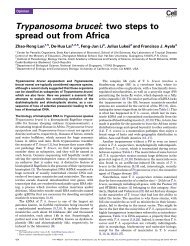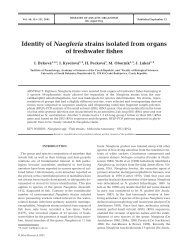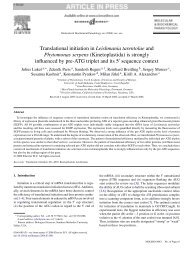Goussia Labbe´ , 1896 (Apicomplexa, Eimeriorina) - Institute of ...
Goussia Labbe´ , 1896 (Apicomplexa, Eimeriorina) - Institute of ...
Goussia Labbe´ , 1896 (Apicomplexa, Eimeriorina) - Institute of ...
Create successful ePaper yourself
Turn your PDF publications into a flip-book with our unique Google optimized e-Paper software.
124 M. Jirku˚ et al.<br />
allowed us to conduct an extensive study <strong>of</strong><br />
members <strong>of</strong> this elusive and overlooked coccidian<br />
genus with consequences for understanding <strong>of</strong><br />
thus far unrecognized taxonomic diversity and<br />
phylogenetic patterns <strong>of</strong> poikilotherm coccidians<br />
in general (Dyková and Lom 1981; Jirku˚ et al.<br />
2002).<br />
The genus <strong>Goussia</strong> was erected to accommodate<br />
piscine coccidia with oocysts possessing<br />
four dizoic sporocysts composed <strong>of</strong> two valves<br />
joined by a longitudinal suture (bivalved sporocysts).<br />
The fine, <strong>of</strong>ten elastic oocyst wall and the<br />
absence <strong>of</strong> an oocyst residuum are other typical<br />
features <strong>of</strong> the genus. Most species are probably<br />
homoxenous, but facultatively a heteroxenous life<br />
cycle was confirmed experimentally for <strong>Goussia</strong><br />
carpelli (Steinhagen and Körting 1990).<br />
Approximately 50 nominal species <strong>of</strong> <strong>Goussia</strong><br />
have been described from freshwater or marine<br />
fish and amphibians. The generic name <strong>Goussia</strong><br />
has a complicated history (Dyková and Lom 1981;<br />
Levine 1983). Although the genus name was<br />
revived by Dyková and Lom (1981), the most<br />
recent taxonomical review <strong>of</strong> the suborder <strong>Eimeriorina</strong><br />
(Upton 2000) lists <strong>Goussia</strong> as a synonym<br />
<strong>of</strong> Eimeria without further comments. However,<br />
the generic name remains recognized as valid by<br />
some authors and new species are being continuously<br />
described assigned to it. Virtually nothing<br />
is known about the relationships <strong>of</strong> <strong>Goussia</strong> to<br />
other coccidian taxa except that the welldescribed<br />
piscine <strong>Goussia</strong> janae Lukesˇ et Dyková,<br />
1990 is not closely related to Eimeria (Jirku˚ et al.<br />
2002; Lukesˇ and Stary´ 1992).<br />
Among amphibian hosts, only larvae <strong>of</strong> anurans<br />
(tadpoles) were found to be parasitized by<br />
<strong>Goussia</strong>. Two intestinal species are known from<br />
anurans. Nöller (1920) described Eimeria neglecta<br />
based on oocysts recovered from tadpoles <strong>of</strong><br />
European Ranids. In 1995, Molnár redescribed<br />
this coccidium, recognized its affinity to fish-host<br />
coccidia and emended its taxonomic status to<br />
<strong>Goussia</strong> neglecta. Later, Paperna et al. (1997)<br />
described <strong>Goussia</strong> hyperolisi from tadpoles <strong>of</strong> the<br />
reed frog Hyperolius viridiflavus from Kenya.<br />
Although <strong>Goussia</strong> infections in the anuran hosts<br />
seem to be restricted to tadpoles and the<br />
disappearance <strong>of</strong> infection during the host’s<br />
metamorphosis was recorded repeatedly (Molnár<br />
1995; Nöller 1920; Paperna et al. 1997), retention<br />
<strong>of</strong> oocysts in liver sinusoids <strong>of</strong> post-metamorphic<br />
frogs was documented only recently (Jirku˚ and<br />
Modry´ 2006).<br />
Herein, we provide data on morphology, biology<br />
and phylogenetic affinities <strong>of</strong> anuran <strong>Goussia</strong>, one<br />
ARTICLE IN PRESS<br />
<strong>of</strong> which is described as a new species, and<br />
describe the relationships <strong>of</strong> European anurans<br />
with their coccidian parasites using several<br />
approaches. Small subunit ribosomal DNA (SSU<br />
rDNA)-based phylogenetic analysis <strong>of</strong> three <strong>Goussia</strong><br />
species from different European anuran taxa<br />
and two fish-host <strong>Goussia</strong> provide novel insight<br />
into the taxonomy and phylogenetic affinities <strong>of</strong><br />
this genus.<br />
Results<br />
Of all examined tadpoles representing five anuran<br />
species, <strong>Goussia</strong> infections were recorded in<br />
tadpoles <strong>of</strong> Rana dalmatina (Loc1), Rana temporaria<br />
(Loc1, Loc2), Pelophylax kl. esculentus (Loc4)<br />
and Bufo bufo (Loc1). Hyla arborea was the only<br />
negative host. In contrast to Locality (Loc) 1 and<br />
Loc3, no infection was recorded in B. bufo<br />
tadpoles from Loc2. Similarly, P. kl. esculentus<br />
tadpoles were infected at Loc4, but not at Loc2.<br />
Free oocysts (Fig. 1) were detected in fresh faecal<br />
samples <strong>of</strong> wild tadpoles examined by the flotation<br />
method. Upon dissections, fully sporulated<br />
oocysts were observed either freely or enclosed<br />
within the yellow bodies in squash preparations <strong>of</strong><br />
intestinal mucosa, intestinal contents and livers<br />
(Figs 2—5) <strong>of</strong> all tadpoles, including those<br />
appearing to be negative based on the examination<br />
<strong>of</strong> faeces by flotation.<br />
Identity <strong>of</strong> Anuran Isolates<br />
The isolate from P. kl. esculentus is treated as<br />
G. neglecta based on morphology and origin from<br />
the type host, and is further characterized by SSU<br />
rDNA sequence. The isolate from B. bufo is<br />
characterized by sporocyst morphology and partial<br />
SSU rDNA sequence and is conservatively<br />
treated as <strong>Goussia</strong> sp. due to the absence <strong>of</strong><br />
ultrastructural and reliable host specificity data.<br />
Based on transmission experiments, <strong>Goussia</strong> from<br />
R. dalmatina and R. temporaria are considered<br />
conspecific. They are morphologically characterized<br />
using the R. dalmatina isolate, and according<br />
to the SSU rDNA sequence divergence, a new<br />
species is proposed, the description <strong>of</strong> which<br />
follows.<br />
<strong>Goussia</strong> noelleri sp. nov.<br />
Oocyst morphology: Shape <strong>of</strong> oocysts variable,<br />
depending on position <strong>of</strong> sporocysts tightly<br />
enclosed by a fine, elastic, colourless oocyst wall








